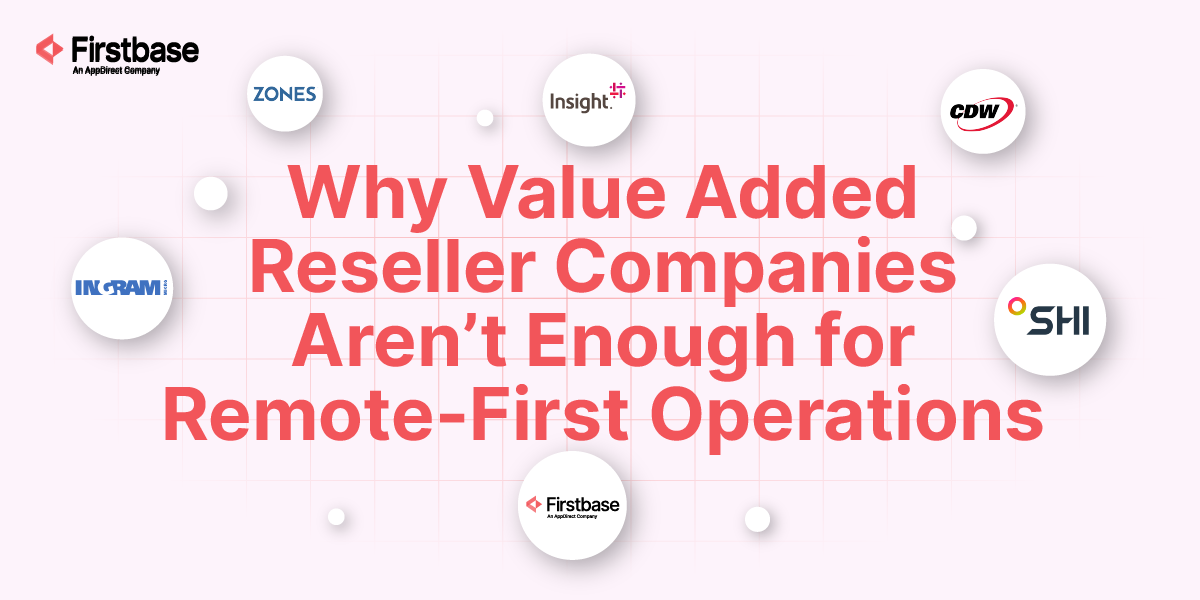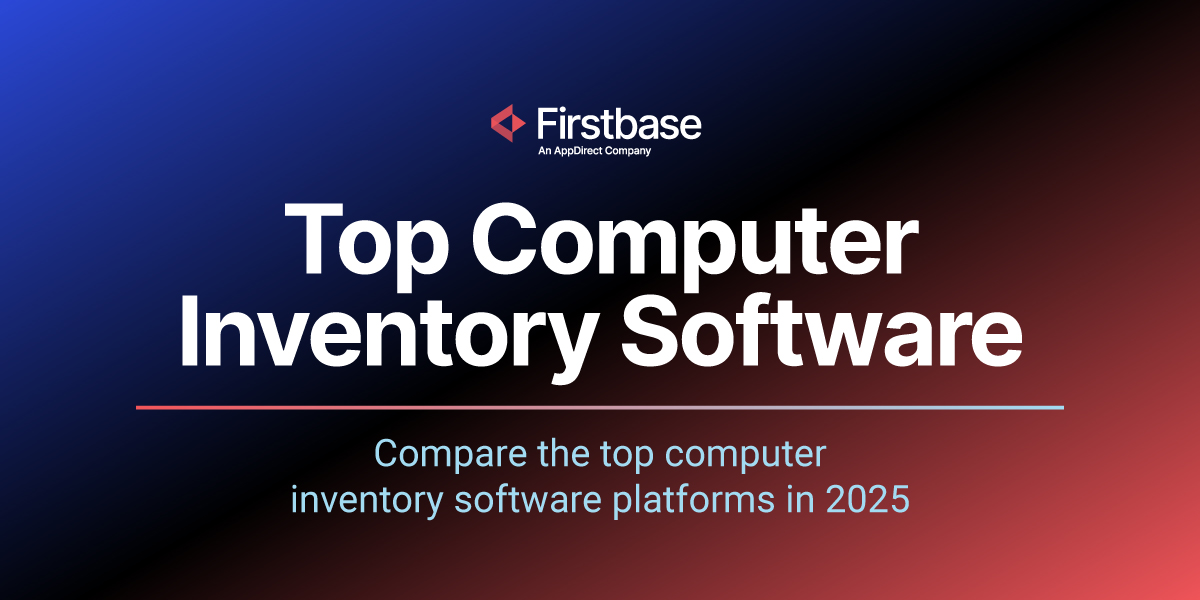Gartner highlights Firstbase in 2025 MDLS Guide for second year in a row >> Get the guide >>
Skip to main content

Compare top managed service Providers in Europe on real-world factors like logistics, customs, retrievals, cost transparency, and SLAs.
2025-12-10

Compare the best tools of 2026 and learn which equipment inventory software truly solves remote logistics, not just asset tracking.
2025-12-09

See how today’s leading hardware inventory tools stack up for remote and hybrid teams. This guide compares CMDBs, ITSM modules, workforce suites, and open-source platforms to guide your decision.
2025-12-08

Check out what makes a remote equipment management tool stand out, and see how the top options compare in real outcomes.
2025-12-05

Learn why discovery tools only reveal what’s on your network. Lifecycle automation closes the gap with global logistics, zero-touch deployment, and automated retrieval.
2025-12-01

Explore which value added reseller companies deliver real global efficiency and where lifecycle automation takes over.
2025-11-04

How Phaidra moved from fragmented processes to a unified, scalable lifecycle with Firstbase.
2025-11-03

See how Asset Panda handles tracking and where it stops short. This review breaks down strengths, gaps, and what today’s remote-first teams actually need.
2025-11-03

Compare global coverage, pricing, and performance across top Allwhere alternatives for reliable IT logistics in 2025.
2025-11-01

Explore key criteria to assess Firstbase alternatives, from delivery SLAs to cost transparency, and see what true IT ops automation looks like.
2025-10-31

Explore top NinjaOne alternatives that handle the full device lifecycle, from global logistics to compliance, not just patching and tickets.
2025-10-30

Compare top Workwize alternatives that improve device tracking, retrieval rates, and cost control for distributed IT operations.
2025-10-27

Compare how leading Growrk alternatives stack up in terms of SLAs, pricing, and integrations.
2025-10-07

Discover the best IT asset management tools for distributed work.
2025-10-06

Find the best MDM platforms for remote teams.
2025-10-02

The best MDM for Apple devices offers global reach, audit-proof compliance, and full asset visibility end-to-end.
2025-09-19

A step-by-step playbook to build your offshore team in Europe. This guide covers hiring models, compliance, and IT logistics.
2025-09-17

Users often recommend ServiceNow on how the platform consolidates ticketing, change management, and automation under one roof.
2025-09-15

Detailed breakdown of pricing, automation, and compliance features to help the IT and finance teams.
2025-09-12

Compare the top computer inventory software platforms in 2025.
2025-09-10

Compare the top ITAD providers for modern fleets. Learn where traditional ITAD falls short, the 5 must-have criteria, and how to recover value without slowing IT.
2025-09-10

Explore five CDW alternatives to optimize your IT asset management. Get SLA-backed deployment, device recovery, and full-lifecycle visibility, built for hybrid and remote scale.
2025-08-26

Explore the top options for full device lifecycle automation across IT, Finance, HR, and Compliance.
2025-08-15

Learn how to set up a secure infrastructure for your team in a hybrid, remote, or in-office setting.
2025-07-09

New hires are too often left waiting, confused, and disconnected. This guide shows you how to streamline onboarding from day one, with real tactics, proven ROI, and scalable processes that delight new employees and free up your team.
2025-07-07

Gain better visibility, control, and compliance with these 5 Deel IT alternatives built for remote IT asset management at scale.
2025-06-04

One platform, full Apple device lifecycle.
2025-05-30

As of May 20, 2025, significant developments in tariff policies are reshaping the landscape for IT procurement.
2025-05-20

From device provisioning to secure retrieval, Firstbase automates global IT logistics, reducing manual work, increasing security, and enhancing employee experience.
2025-04-25

New tariffs are driving IT hardware prices up 8–20%, disrupting global supply chains and forcing companies to rethink procurement. Firstbase breaks down what’s happening, who’s impacted, and how to stay ahead with smart buying strategies.
2025-04-08

Get the practical framework for AI adoption in IT with this guide to AI in IT. Learn how IT plays a critical role in IT governance and why IT leaders will become central to businesses leveraging AI.
2025-04-01

As devices reach the end of their life cycle, organizations face significant risks related to data security, compliance, sustainability, and operational efficiency.
2025-03-05

Learn how to simplify IT offboarding, recover lost assets, and enhance security—without the headaches.
2025-03-05

Docebo partnered with Firstbase to replace manual IT and HR workflows with automated, secure, and scalable processes.
2025-03-04

Home office closets are usually filled with winter coats or workout gear. But one year ago, Cresta’s Head of IT Jared Allenbrand had a closet crammed with approximately 100 employee laptops. Not anymore.
2025-02-18

When you try to scale in LATAM on your own, IT organizations often bear the brunt of execution.
2025-02-14

The shift to remote and hybrid models isn’t just a trend—it’s a transformation that will define the next decade of work says CEO Chris Herd on the CIO Influence Interview.
2025-02-12

AppDirect is a recognized industry-leading B2B subscription commerce platform.
2025-01-23

Streamlining employee offboarding is critical for securing data, retrieving assets, and reducing costs.
2025-01-14

That’s exactly why 66% of U.S. companies outsource at least one department, a trend that translates to approximately 300,000 American jobs being transitioned offshore each year.
2025-01-09

Learn proven strategies for leading distributed teams—streamlining remote onboarding, boosting productivity, and fostering accountability without micromanagement.
2024-12-18

Learn how to modernize end-user computing to meet the needs of the remote and hybrid workforce
2024-12-18

Discover how Firstbase and WeWork are redefining distributed work by combining global workspace access with zero-touch IT provisioning for seamless, scalable team management.
2024-11-13

Unlock the secrets to IT operational excellence with our comprehensive guide, designed specifically for CIOs. It offers proven strategies and insights to streamline your IT logistics and enhance productivity.
2024-11-06

Apple’s new M4 MacBook Pro introduces AI-powered performance gains, and Firstbase helps businesses simplify global procurement, upgrades, and device management at scale.
2024-10-24

Thomas Olson from New Relic is the Manager of IT Program Management and the driving force behind leveraging Firstbase to streamline their IT Logistics globally.
2024-10-01

Watch how IT leaders and Finance leaders need to come together to fuel business growth.
2024-09-13

Discover how Brightwheel streamlined IT operations with Firstbase, reducing time spent on IT equipment management, enhancing efficiency, and empowering focus on core educational goals.
2024-09-13

Firstbase and MDMs are complementary tools for IT security and efficiency. Elevate all your IT logistics from one centralized hub.
2024-07-19

Zero-touch IT environments are considered the gold standard of IT environments, yet device provisioning and asset management can pose challenges beyond the scope of MDM solutions. This eBook details how to extend the power of JAMF, Kandji, JumpCloud, and Intune by focusing on the first touch point from procuring a device until your employees receive their new device.
2024-07-01
.png)
Struggling with delayed onboarding, cumbersome offboarding, and increased HR/IT workload? Discover how Firstbase can streamline equipment management, ensuring smooth operations and boosting productivity for your global workforce.
2024-06-19

Learn how to master IT logistics with our e-book, ‘Mastering IT Logistics: The Three Rs,’ and discover strategies for efficient Retrieval, Reuse, and Recycling of IT assets to streamline operations, reduce costs, and enhance sustainability.
2024-06-12

Efficiently sync and manage hardware assets across platforms in the physical and digital world.
2024-06-12

In an era where technology evolves at breakneck speed, ensuring your team has the most efficient
2024-04-10

Unlock the secrets of effective IT management in a distributed or international company.
2024-02-16

CIO.com recently published 10 Top Priorities for CIOs in 2024 and in the ever-evolving landscape of IT leadership.
2024-02-06

Seamlessly manage global assets from procurement to recycling
2024-01-17

Discover the significance of effective off-boarding for organizations, both from HR and IT perspectives, and gain insights into establishing a robust IT off-boarding process for remote employees in this on-demand webinar.
2023-11-17

Apple’s newest processor boasts a large increase in compute power, yet the recent introduction of the M3 processor has many business leaders asking do we really need it?
2023-10-12

The right digital workforce solutions can drive productivity, collaboration, and employee engagement, improving business outcomes.
2023-08-31
.png)
In this case study, we explore how an enterprise technology consulting firm tackled the challenges of managing an increasing headcount and device lifecycle needs.
2023-08-31

Discover how Benefex, the innovative team behind the award-winning employee experience platform OneHub, streamlined its internal processes for managing devices across its global workforce.
2023-08-30

With a distributed workforce where workers are scattered across the world, achieving high rates of remote employees returning equipment is very complex and time-consuming for your IT team to handle.
2023-08-25

Let's assess the strengths and limitations original equipment manufacturers (OEMs) have in providing and managing your employee's corporate devices on a global scale.
2023-08-17

Firstbase is now an Apple Authorized Reseller, highlighting its top-tier remote equipment management. Elevate your hybrid work experience with us.
2023-08-09

Let's break down the advantages and limitations of partnering with value-added resellers (VARs) to outsource device lifecycle management.
2023-08-04

As an IT admin or procurement manager, it is vital to understand the benefits and constraints of partnering with a managed service provider (MSP) to provide device lifecycle management.
2023-07-28

Let's compare BYOD, COPE, COBO, and CYOD employee equipment provisioning models to see which is best for your organization.
2023-07-21

Equipping and supporting a distributed workforce with all the IT and ergonomics they need to start and stay productive is challenging. It’s also more costly than most realize.
2023-07-20

Digital workplace solutions have become integral in shaping the future of work and increasing employee and customer retention. Here's what to consider when choosing your infrastructure of tools, apps, and platforms.
2023-07-19

With PCaaS (PC as a Service), organizations can simplify IT, reduce costs, streamline business needs, and improve the employee experience.
2023-07-17

Device lifecycle management (DLM) has been complicated by remote work. Here's how automation helps streamline management end-to-end to improve productivity and the employee experience.
2023-07-13

This webinar explains the need for automating end-user computing processes to effectively manage remote workers, asserting that efficient management can boost revenue growth by 25%. The video presents a comprehensive look at transitioning from outdated legacy systems to automated processes and showcases how the Firstbase platform can simplify the employee equipment process.
2023-07-13

Here's what to expect out of remote workspaces, including tips for designing a comfortable environment and how to overcome unique challenges.
2023-07-10

Remote work onboarding creates unique challenges for organizations. Learn how to overcome these challenges including equipping distributed workers for success.
2023-07-07

In office settings, supplying IT accessories on demand to workers was easy, but it gets harder with a distributed workforce, especially when employees are global. This is where a cloud-based virtual IT closet comes into play.
2023-07-05

The "IT Operations Blueprint for Distributed Work" eBook provides comprehensive best practices for managing IT processes in a remote or hybrid work environment. Compiled by a highly experienced Ops team, the guide covers everything from equipping employees to managing equipment breakages and retrievals in a distributed work setting.
2023-06-29

We're thrilled to announce that Firstbase has received the prestigious 2023 RemoteTech Breakthrough Award for our game-changing Employee Onboarding Solution. Transform your remote onboarding process and boost productivity with Firstbase. Request a demo today.
2023-06-22

Join us in this illuminating webinar as we explore the shifting landscape of end-user computing in response to the rise of flexible work.
2023-06-21

Learn how modern IT leaders are thinking about the challenges they face in 2023, in this report co-sponsored by Firstbase.
2023-06-13

This case study reveals how Verse used Firstbase's solution to enhance its remote employee experience and automate the full lifecycle of equipment management.
2023-06-12

Discover how to boost employee retention and productivity through effective onboarding and an empowering digital environment in this essential guide for HR professionals and team leaders.
2023-06-02

Why are remote work IT shipping costs so high? And how do you solve for them? Find out in this blog that you'll want to share with your CFO.
2023-05-31

Modernizing End User Computing for Hybrid Work is a comprehensive webinar offering insights into the rapidly changing landscape of end-user computing, brought on by the rise of hybrid and remote work.
2023-05-30

Retrieving remote worker equipment is hard, and most companies are losing a significant percentage of their deployed remote work IT assets. Learn why and how you can dramatically improve your retrieval rates.
2023-05-24

End-user computing (EUC) is an IT discipline that refers to a set of technologies that enable workers to access remote applications and data safely and securely. EUC encompasses a range of different technologies and processes that address deployment, configuration, maintenance, security, and performance management of devices, software, and cloud-based services.
2023-05-15

Hardware as a service (HaaS) is the latest method for procuring and maintaining IT infrastructure, combining procurement and lifecycle services on a subscription basis.
2023-05-09

According to industry estimates, up to 80 million (out of 255 million) desk jobs will be primarily remote by 2030.
2023-05-07

Remote work has undeniably changed the traditional structure of the workplace.
2023-05-02
.png)
On March 15th, 2023, we announced our Spring ‘23 Release, our biggest release yet. Thank you to those who were able to join us! There were a lot of new features and enhancements announced, so we've prepared a brief recap to get you up to speed with everything in Spring ‘23.
2023-03-21

We're excited to announce the Firstbase Integration Hub powered by Workato’s Intelligent Integration and Automation platform. The Firstbase Integration Hub will enable our customers to connect to 1,000+ SaaS apps, databases, AI services, APIs, and more without writing any code.
2023-03-15

Enterprises are striving to become increasingly digital in their business model. But is your IT operating model strong enough to help achieve your organization's digital ambition?
2023-03-01

Many Fintech companies have leaned into remote work. A recent search on builtin.com showed over five hundred Fintechs with remote work programs, and 185 that were fully remote. In this blog, we’ll look at the drivers for the growth of remote work in Fintechs and key considerations for how to best equip remote workers to maximize retention, engagement, and productivity.
2023-02-13

Hardware-as-a-Service (HaaS) is a powerful way to procure end-user computing equipment. It offers an effective way to conserve cash, keep IT equipment off your balance sheet, and keep your employees happy with the most up-to-date equipment. When combined with self-service automation, HaaS is an attractive path for organizations looking to better serve remote workers.
2023-01-31

These steps are drawn from the Gartner research report “How to Best Equip Home Workers,” by Stephen Kleynhans, which is the Firstbase highlighted research report for January 2023. You can get that report until the end of January with complimentary access.
2023-01-25

Join us on this episode of Against the Herd, where we chat with Chase Warrington, Head of Remote at Doist.
December 9, 2025

Against the Herd with Saket Srivastava (CIO at Asana)
December 9, 2025

Denise Brouder delves into the transformation of work and life in the digital age. Discussing empathy, the value of human touch points, and our role in shaping the future, Brouder offers insightful perspectives. Dive deep into the balance between flexibility and fulfillment. Video & transcript available.
December 9, 2025

Explore the insightful conversation between Chris Herd and Tracy Keogh as they discuss the future of remote work, the impact on cities, and the importance of work-life balance.
December 9, 2025

Join us for an insightful discussion between visionary leaders, Job van der Voort and Chris Herd. Explore the fusion of virtual reality and remote work, the expanding reach of AI, time management insights, and Job's optimal remote work setup. Discover the exciting possibilities that lie ahead in the world of work. Read the full transcript below.
December 9, 2025

Experience a riveting conversation between tech mavens Chris Herd and John Winsor about the evolving world of work. This blog post offers a snapshot of their chat, exploring insights into distributed teams, adaptability, and the quest to find the sweet spot in a dynamic business environment. Dive in to tap into their wisdom and perspective.
December 9, 2025

Join Chris Herd and Steve Todd in this engaging conversation on the future of workspaces. From the impact of the pandemic on real estate to the role of technology in shaping the future of work, they dive into the challenges of staying relevant in a constantly changing world. Tune in as they explore the shift towards a hybrid work model and offer valuable insights into the ever-evolving landscape of work.
December 9, 2025

Dive into the insights shared by Chris Herd and Allison Baum Gates on the future of work. Explore the intersection of generational differences and technology, the evolution of communication, and the rise of visual platforms. Learn about the importance of founder-market fit in entrepreneurship. This discussion paints a vivid picture of the dynamic world of work.
December 9, 2025

Are you ready to go Against the Herd? This episode features Howard Lerman, Founder & CEO of Roam, and co-founder & former CEO of Yext. Learn about Howard's unique insights on operating a distributed company, operating as a CEO in a public company, and his insights on leadership in the age of digital transformation.
December 9, 2025